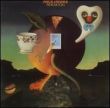| gx1327 |
|
22 Apr 2010 13:47 | Quote |
Joined: 20 Sep 2009 United States  Karma Karma: 9 
|
trying to learn progressions. starting with the basic major progression -- I ii iii IV V vi vii* I
using a basic scale (G) plotted out the pattern of where the major and minor (and dminished) chords appear.
using this pattern i tried to recognize songs which i've learned. for instance, the chorus to sublime's "same in the end" goes I, V, iii, vi, V, IV, I, iii. i see that.
but looking at weezer's "say it ain't so" (which has a simpler 4 chord progression) i'm wondering if anyone can explain it to me. the song is written in D# tuning (every string 1/2 step down), but the chords are:
Cm > G > G# > D# (which can easily be played as 5-string minor on the 4th fret, 6-string major on the 4th fret, 6-string major on the 5th fret, then 6-string major at the 0 fret, "open E major").
looking at the major scale / major progression, with G>G#, this is either in the key of D# or the key of G#. however:
in they key of D#, the third chord (G) should be a minor chord. in the song it is a major chord
in the key of G#, the sevent chord (G) should be a diminshed chord. in the song it is a major chord.
is this simply a different progression? just a varaition of a progression that "sounds good"? any insight? i'm curious how they came up with this sequence of chords which sounds pleasing to the ear! |
| JustJeff |
|
22 Apr 2010 15:18 | Quote |
Joined: way back United States  Lessons: 2 Karma: 21 
|
So you've opened up the flood gates to the wonderful world of modal shifts :)
Basically, what is happening is that the G that is used is outside of your mode. You start in C aeolian (C minor). Then with a nifty trick, we borrow from another mode, namely C Lydian. (Lydian is basically the same progression except you start on the 4th of the scale... so i.e. C Lydian means that you have a C major, D major, and G major chords. We borrow from this key to get that G major chord.
Read through some of the Mode tutorials on this page to find out a bit more... but that's your basic idea. |
| gx1327 |
|
23 Apr 2010 09:13 | Quote |
Joined: 20 Sep 2009 United States  Karma Karma: 9 
|
i assumed but may as well ask; do progressions have modes in the same way that scales have modes?
|
| JustJeff |
|
23 Apr 2010 10:24 | Quote |
Joined: way back United States  Lessons: 2 Karma: 21 
|
A scale is collection of 7 tonal values that make up a key.
A tonal chord is a chord of 2 or more of these tonal values in a single key.
Technically, everything has modes... like for example
In D Ionian
I, IV, V, I
D, G, A, D
In D Aeolian
i, iv, v, i
Dmin, Gmin, Amin, Dmin
Do you understand this notation?
Now, to be specific, these two "progressions" have completely different feelings, being in different keys of course. I have no idea if that actually works, but this is how I understand it. |
| RA |
|
23 Apr 2010 12:08 | Quote |
Joined: 24 Sep 2008 United States  Karma Karma: 16 
|
I'm sorry Jeff but I have no clue what your talking about or trying to get to. even if you moved to C lydain you only get one chord the G there no D major it's D# sharp.
also if there is confusion about modes, all modes are scales to clarify. All a mode it is a scale that shares all the same notes with the starting scale. For example, Alternate scale = modes of melodic minor, Lydian is a mode of Aeolian, Spanish gypsies = mode of harmonic minor. My be think of modes as transforms, in that in Car "MODE" and People "MODE" that share the same parts but ones a car ones are robot from space with guns.
I'm sorry if that comes out rude or i miss understood, I'm doing this quick and it is not my intention.
Now on to the original question. The key is the key of C (or what is the actual chord your playing, sometime people still call the third fret C even when c capoed or down tuned and i don't know if that's what you doing.
now to state what's going on in the progression, any time you start with minor chord follow by a major chord a fifth lower(Dm to A, Em to B) to need to be thinking Minor/major tonality(what going on is the third of the fifth chord[in this case "G major" which is B] is the 7th of the root chord(B is the leading tone(7) of C)). But as you should know minor scales(in major/minor tonality of thought, in Western music) don't have a natural 7th that all have b7ths.
Show whats common scales Do? that would be Harmonic minor of melodic minor. To find out what one look at the next chord which is G# major. any time the fifth is followed but a major chord a step up, it is harmonic minor, but more importantly it is a "Andalusian cadence"
--so if you got a [ i, V, bVI] progression 90% of the time it's going to be a "Andalusian cadence"---
-----http://en.wikipedia.org/wiki/Andalusian_cadence------
but after you read that you going to see that "say it ain't so" doesn't follow it perfectly, you right it's actually a different motif that based off of it. So people who like to think of building there chords out modes are going to say that the D# should be Aug, but that's not how this works. The Andalusian cadence it more about Harmonic functions then melodic, even the based progression doesn't work diatonic-ally with Harmonic minor. The is a reason for the D# major but I'm not going into it, just know when doing this people like to make chords based of the iii major(C 3rd is Eb aka D#).
now if what your looking for is what scale to play? sometimes(actually a lot) it is best not to think in terms of scales and just to play the chord changes and the melody with add notes that sound good to you. Now doing that it good to know the relationship between the next chord if you make each the root. From C to G is a 5th,G to G# you should know, G# to D# is a 5th, then turn around with a 6th D# to C. So just play the changes with the melody always with the melody. just in case you don't know what i mean by play the changes the notes of the chords.
That being said a reason why it is so popular is a lot can be done with this progression and i mean a lot. but just because it's based off of harmonic minor i would not play harmonic i wouldn't even be thinking harmonic minor if it turned out i was playing it note for note. DON"T PLAY HARMONIC MINOR |
| JustJeff |
|
23 Apr 2010 14:22 | Quote |
Joined: way back United States  Lessons: 2 Karma: 21 
|
@RA
What I said was the G is BORROWED from another key. Basically, we don't STAY in this new mode, we only shift to it for one chord to borrow it. Then we shift back.
To your scale question, sure the whole "playing what sounds good" works, but why do that when you can understand WHY it works? This is the point of music theory...
Guarantee this will work, without even trying it:
For the given progression, play these scales over them:
C Aeolian, G Ionian, G# Lydian, D# Ionian
This is the power of modes. |
| adelaideguitar |
|
24 Apr 2010 09:02 | Quote |
Joined: 14 Apr 2010 Australia  Karma Karma: 3 
|
The first 3 chords are from C harmonic minor.
But, the D# aug sounds awful, so they play a D# major, which is from C natural minor. When you swap from harmonic to natural minor, it is often called melodic minor, and the selection of the 7th vs raised 7th is composer dependant. There are different rules for note selection. eg: Direction of melody or if you want a Aug chord or not.
ie: People choose what they prefer to hear.
http://en.wikipedia.org/wiki/Minor_scale
Quote: Composers have not been consistent in using these in ascending and descending melodies. Just as often, composers choose one form or the other based on whether one of the two notes is part of the most recent chord (the prevailing harmony). Particularly, to use the triad of the relative major—which is very common—since this is based on the third degree of the minor scale, the raised seventh degree would cause an augmented triad. Composers thus frequently require the lowered seventh degree found in the natural minor.
Note: I recently have been looking into harmonic scale chords and the augmented chord (which I hate). There are a number of replacements for the 3rd chord of the harmonic scale.
http://www.all-guitar-chords.com/topic.php?id=3904
|
|
|






